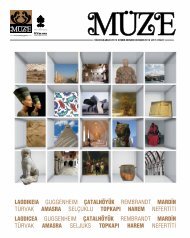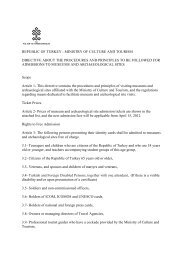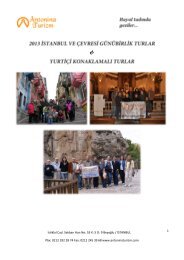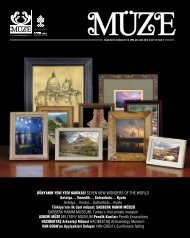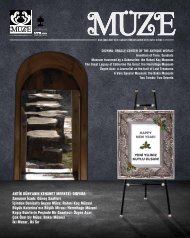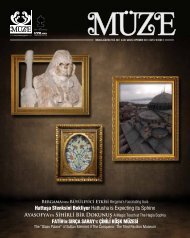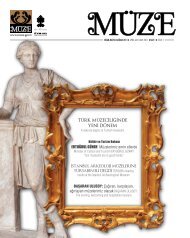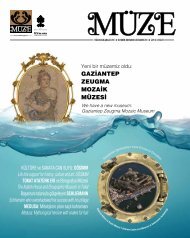Bir adam kendisine çocuk veren kadından ayrılmak isterse ... - MÜZE
Bir adam kendisine çocuk veren kadından ayrılmak isterse ... - MÜZE
Bir adam kendisine çocuk veren kadından ayrılmak isterse ... - MÜZE
Create successful ePaper yourself
Turn your PDF publications into a flip-book with our unique Google optimized e-Paper software.
iri tufan benzeri yıkımlarla sona ermiş olan dört devir geçirmişti. 2012 yılında da son<br />
devir, yani “5. çağ” bitecekti. Ve bu da yine bir yıkımla gerçekleşecekti.<br />
Küçük-cesur insanlar<br />
Bu sorunun yanıtını almak için fazla beklemeyeceğiz. O tarihe sadece aylar kaldı artık.<br />
21 Aralık’ta sahiden bir yanıt alır mıyız, alırsak bu nasıl tecelli eder? “<strong>Bir</strong> zamanın sonu”<br />
tufanla mı yoksa büyük bir savaşla mı gelir? Kimbilir!<br />
Ama her ne olursa olsun, 2012 kehanetlerinin Mayalar’ı tanımak için güzel bir fırsat<br />
verdiği ortada.<br />
Arkeolojik bulguların çizdiği portreye göre gerçekten de tanımayı hakkeden bir uygarlıktı<br />
Mayalar:<br />
• Boyları ortalama 1.54 metreydi... Siyah ve düz saçlı, geniş omuzluydular.<br />
• Kadınları toplumun eşit parçasıydı. Sadece üretimde -yani ekonomide- değil yönetimde<br />
de yeri vardı. Pekçok kadın üst düzey mevkilere gelmişti.<br />
• Anaerkil bir toplum değildi. Ancak yeni evliler en az birkaç yıl kızın evinde yaşamak<br />
zorundaydı.<br />
• Askeri, idari ve toplumsal yapı net ama aynı zamanda çok ayrıntılı biçimde düzenlenmişti.<br />
Sosyal piramidin en üstünde -yine kadının yerini vurgular biçimde- “babalar ve<br />
anneler” denilen soylular bulunuyordu. Aşağı doğru indikçe yerel başkanlar, komutanlar,<br />
mahalle sorumluları ve düzeni sağlayan bir tür polis yer alırdı.<br />
• MS ilk yüzyıllarda bile lezzeti keşfetmişlerdi. Suyu asla sade içmiyorlar; daha çok<br />
meyve özleriyle karıştırarak içiyorlardı. Temel gıda maddesi mısırdı ve mısırla çok zengin<br />
bir mutfak kültürü yaratabilmişlerdi. Örneğin tortilla muhtemelen Maya mutfağından<br />
mirastı. İçine et ve sebze koydukları küçük hamurları kızartarak ya da haşlayarak yiyorlardı.<br />
Kakao tohumundan elde edilen hamuru da su ya da sütle karıştırarak çok özel<br />
bir içecek yaratmışlardı. Adı “xolocatl” olan bir içecek!<br />
Bunlar, Mayalar hakkında kaba bir özet. Ama bu kadarı bile daha fazla öğrenme,<br />
Mayalar’ı tanıma isteği uyandırmıyor mu!<br />
Meksika’da yer alan Palenque antik kenti (sol sayfa),<br />
Uxmal antik kenti kazılarında bulunan tanrı heykeli,<br />
Yucatan, Meksika (sol altta). Tulum, Maya kalıntıları ve<br />
muteşem sahilleri nedeniyle Teotihuacan ve Chichen<br />
Itza’dan sonra Meksika’nın en çok turist çeken üçüncü<br />
bölgesi (yanda).<br />
Palenque Ancient City in Mexico (left page), god<br />
sculpture unearthed at Uxmal Ancient City, Yucatan,<br />
Mexico (left page, below). Tulum is Mexico’s third most<br />
popular touristic destination after Teotihuacan and<br />
Chichen Itza, due to its Mayan ruins and spectacular<br />
beaches (left).<br />
points out to the 21 st December 2012 as the<br />
date of the end of all times. What did the Mayans<br />
mean by that prediction? Did they mean<br />
apocalypse, the end of the world, or did they<br />
augur the emergence of a totally new era, such<br />
as it is being interpreted by some authors?<br />
Those adopting this interpretation remind the<br />
Mayan periodisation of history according to<br />
which mankind went through four successive<br />
eras ending each with a deluge-like disaster.<br />
In this framework, the year 2012 is to mark the<br />
end of the 5 th era and this would also correspond<br />
to an ending triggered by some sort of<br />
cataclysm.<br />
Little courageous people<br />
We do not have to wait long to get the answer<br />
to the above question; we are only months<br />
away from the 21 st of December. Who knows<br />
if we are expecting a big flood or a big war! In<br />
any event, their 2012 predictions constituted<br />
an opportunity for trying to learn more about<br />
the Maya Civilization.<br />
Some characteristics:<br />
• Their height was around 1,54 m. They had<br />
black straight hair and broad shoulders.<br />
• Women enjoyed equal rights in society; their<br />
prerogatives were not limited exclusively to<br />
the economic field; they were also seen in<br />
higher posts in administration.<br />
• It was not a matriarchal society, but newlywed<br />
couples had to live in the bride’s house<br />
during the first few years of the marriage.<br />
• Military, administrative and social structures<br />
were articulated in clear and detailed terms.<br />
On top of the social pyramid were placed the<br />
nobles called “fathers and mothers” thereby<br />
emphasizing the position of women in society.<br />
In descending order from the top were the local<br />
presidents, commanders, district authorities<br />
and, a sort of law enforcement task force<br />
comparable to the police.<br />
• They had developed taste and flavour preferences<br />
already in early centuries AD. They never<br />
drank pure water, but always mixed it with<br />
fruit juices. Basic food was corn with which<br />
they created a rich culinary culture. Presentday<br />
Mexican tortillas are probably a Mayan<br />
heritage. They used to eat little cooked or fried<br />
pieces of corn-dough filled with vegetables or<br />
meat. They also prepared dough with cacao<br />
seeds, which they mixed with milk or water to<br />
create a special drink, the “Xolocatl”- not too<br />
far from chocolate.<br />
This is just a rough summary of some Mayan<br />
traditions inciting to learn more about them.<br />
61



